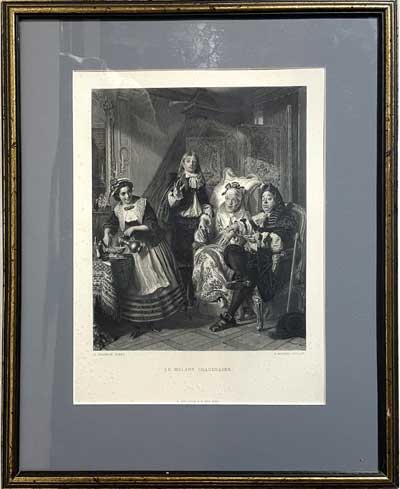
LE MALADE IMAGINAIRE
H. Brurne after A.Solomon
1823 -1862
Uncoloured steel engraving . Published by D.Appleton & Co New York Ca.1861
Museum matted, glazed, gilt-wood frame. 10 7/8 x 7 ¼” Frame 16 3/4 x 13 ¼ ”
Ref. JH5(203)/DNN/ s.anaa> ASL PRICE CODE B SOLD
"'Le Malade Imaginaire' is almost the last work Abraham Solomon produced; and is unquestionably the most humorous, as it is also one, in every respect, the most clever in delineation of character; for there is point in every figure. The subject is borrowed from Moliere's comedy bearing the same title.
The scene lies in the bed-chamber of the hypochondriac, M. Argan, who is visited by his physician, Diafoirus, and the son of the latter, who is training for the profession.
Propped up and pillowed in his easy chair, no wonder the invalid looks up aghast when the young oracle has spoken such ominous words, and he finds them confirmed by the elder man of physic, who, watch in hand, times the beating of the patient's pulse as his jewelled fingers press lightly on Argan's wrist. There is something irresistibly droll in the trio; in the pompous attitude and whole bearing of the physician, who is evidently not inclined to thwart the fancy of his patient, though we can detect a degree of humour in his countenance. And then the dismayed expression of Argan's face, as if he were already doomed to death; while young Diafoirus delivers the sentence with an emphatic upraising of the hand to enforce it: his father, no doubt, had given him suitable instructions what to say. Toinette, the "femme qui n'aime, makes no secret of the opinion she entertains regarding the sick man's state of health: she is busy mixing a compound of some kind or other for the invalid, who is always requiring a stimulant "to keep up the tabernacle," as we once heard an old Scotch physician remark to one under his care; but the dialogue of the two doctors amuses her much, and she looks towards Diafoirus as perfectly comprehending its raillery, and also as quite ready to carry on the delusion after he and his son have taken leave. Every part of this most humorous picture is painted with scrupulous care and attention to details: the costumes of the figures are rich in colour, and the arrangement of light and shade is very effective. This painter was much accustomed to rely on gorgeous draperies and splendid accessories of every kind to give value to his compositions." The Art Journal 1871 & The Victorian Web




